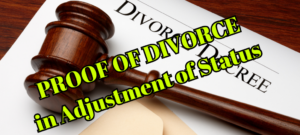
Filing for Adjustment of Status and unsure what documents to include in your filing? You’ve come to the right place!
If you are applying for a green card through adjustment of status, a concurrent filing of Form I-130 (Petition for Alien Relative) and Form I-485 (Application to Register Permanent Residence or Adjust Status) is often the best option for those eligible to apply from within the United States. Properly preparing your application is crucial to avoid delays, so gathering the necessary documents ahead of time is key.
Below is a checklist of the primary documents you’ll need for your adjustment of status application, with explanations for each:
1. Applicant’s Birth Certificate
A certified copy of the applicant’s birth certificate (with a certified English translation, if applicable) is required to establish identity and age. If a birth certificate is unavailable, alternate evidence of birth may be submitted, such as a family registry or church records.
2. Passport
Submit a photocopy of the biographical page of the applicant’s passport, as well as any pages with visas or admission stamps. This document helps confirm the applicant’s nationality and any previous entries into the U.S.
3. Proof of Legal Entry
If the applicant entered the U.S. with a visa, provide a copy of the I-94 Arrival/Departure Record or the visa stamp in the passport. This establishes that the applicant was lawfully admitted or paroled into the U.S., a key requirement for adjustment of status eligibility.
4. Proof of the I-130 Petitioner’s U.S. Citizenship or Lawful Permanent Resident (LPR) Status
Since the I-130 petitioner must be a U.S. citizen or LPR, include one of the following documents to prove their status:
-
- U.S. passport
-
- Certificate of naturalization
-
- U.S. birth certificate (for citizens by birth)
-
- Permanent resident card (green card)
5. Marriage Certificate
If you are applying for adjustment of status based on marriage to a U.S. citizen or LPR, you must submit a copy of your marriage certificate. Ensure it is a certified copy from the appropriate civil authority.
6. Proof of Bona Fide Marriage
USCIS will want proof that your marriage is genuine and not solely for immigration purposes. You should provide a variety of evidence, such as:
-
- Joint lease or mortgage documents
-
- Joint bank account statements
-
- Photos of you and your spouse together (including with family and friends)
-
- Utility bills showing both names
-
- Life or health insurance policies listing each other as beneficiaries
7. Proof of Dissolution of Any Previous Marriages
If either spouse was previously married, you must provide proof of divorce, annulment, or death of any former spouse. This ensures that your current marriage is legally valid.

8. Documents for the I-864 Affidavit of Support
Form I-864 (Affidavit of Support) is required to show that the petitioner (or a joint sponsor, if needed) can financially support the applicant. You’ll need:
-
- The petitioner’s most recent tax return (typically the last three years are helpful)
-
- W-2s or 1099s corresponding to the tax returns
However, and it is important to note, that additional documents to establish proof of eligibility may be required if there are issues concerning the Sponsor’s financial background and history, which will be discussed in a separate article.
9. Additional Documents Based on I-485 Part 9 (General Eligibility and Inadmissibility Grounds)
Depending on the applicant’s answers in Part 9 of Form I-485, USCIS may require additional documentation. Common examples include:
-
- Criminal History:
If the applicant has ever been arrested, charged, or convicted of a crime, you must submit:
-
- Certified court records of the arrest or conviction
-
- Police reports
-
- Evidence of rehabilitation, such as completion of probation or community service
-
- Criminal History:
- Previous Immigration Violations:
If the applicant has previously been ordered removed or has overstayed a visa, documentation of those events, including any waiver applications, may be required.

10. Medical Examination (Form I-693)
USCIS requires applicants to submit a medical examination performed by a USCIS-designated civil surgeon. The results are recorded on Form I-693 and must be sealed in an envelope by the doctor.
11. Two Passport-Style Photos
Provide two recent, passport-style photos of the applicant, taken according to U.S. Department of State guidelines (2×2 inches, white background, no glasses).
Conclusion
Submitting a complete adjustment of status application is essential for avoiding delays or Requests for Evidence (RFEs). Remember that depending on your personal situation, additional documents may be required. If you’re unsure about any part of the process, it’s always best to consult with an experienced immigration attorney who can guide you through the process and ensure your application is properly prepared.
Contact Us for Help with Your Adjustment of Status Case
If you have any questions about your adjustment of status case or need help preparing your application, contact Gabriel Sandoval at GS LAW, APC today. We specialize in guiding clients through the complex immigration process with personalized attention and expert legal advice.
Office Address:
GS LAW, APC
15260 Ventura Blvd. Ste 1200
Sherman Oaks, CA 91403
Toll Free: (800) 919-8959
Local: (213) 725-2919
Email: info@gslawoffice.com


